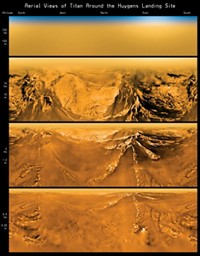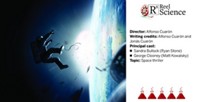Advertisement
Grab your lab coat. Let's get started
Welcome!
Welcome!
Create an account below to get 6 C&EN articles per month, receive newsletters and more - all free.
It seems this is your first time logging in online. Please enter the following information to continue.
As an ACS member you automatically get access to this site. All we need is few more details to create your reading experience.
Not you? Sign in with a different account.
Not you? Sign in with a different account.
ERROR 1
ERROR 1
ERROR 2
ERROR 2
ERROR 2
ERROR 2
ERROR 2
Password and Confirm password must match.
If you have an ACS member number, please enter it here so we can link this account to your membership. (optional)
ERROR 2
ACS values your privacy. By submitting your information, you are gaining access to C&EN and subscribing to our weekly newsletter. We use the information you provide to make your reading experience better, and we will never sell your data to third party members.
Policy
Space Exploration
Book explores critical years of Jet Propulsion Laboratory at Caltech
by John M. Logsdon
April 23, 2007
| A version of this story appeared in
Volume 85, Issue 22

Peter Westwick's study is a follow-on to a 1982 book by Clayton Koppes with the same title. That initial book traced the early history of California Institute of Technology's Jet Propulsion Laboratory (JPL) from its origins through the departure of its longtime director, William Pickering, in 1976. Westwick picks up the JPL story with the arrival of a new laboratory director, Caltech professor Bruce Murray, and carries it most of the way through the spectacular success of the two Mars Exploration Rovers, Spirit and Opportunity, which landed on the red planet in January 2003 and to this day are carrying out their path-breaking investigations.
The book "Into the Black: JPL and the American Space Program, 1976-2004" is organized around the tenures of three JPL directors: Murray, who served from 1976 to 1982; retired Air Force Gen. Lew Allen, who led the laboratory from 1982 to 1991; and another Caltech professor and veteran planetary scientist, Ed Stone, who succeeded Allen and left his position in 2001. The core of the book deals with this 25-year period.
Unfortunately, only a brief epilogue discusses events in 2001-04, and ever since, when JPL achieved a number of major successes. Still, the book's organization is useful, because the three individuals were different in their personal characteristics and their approaches to leading JPL, and these differences provide a useful window through which to view JPL's changing fortunes.
Murray was the agitator, trying to push JPL in new directions and intervening in the political process to try to ensure the laboratory's survival as a center for planetary exploration as space priorities shifted.
Allen had been Air Force chief of staff and brought a somewhat distant command presence to the position; he restored a sense of order to JPL activities while stressing the technological foundations of the organization's excellence.
Stone was a genial, consensus-oriented Caltech professor with a solid scientific reputation derived from his role as project scientist for the Voyager missions to the outer solar system. He had a flair for public relations and a reputation for personal and professional integrity. Stone guided JPL through the difficult post-Cold War years as it downsized its staff and struggled with mixed results to adopt a new approach to planetary exploration labeled "faster-better-cheaper."
Each of the three directors contributed to the image of JPL as a leading example of scientific and technological excellence, an image it retains today.

The Jet Propulsion Laboratory is a federally funded research and development center managed for the National Aeronautics & Space Administration by Caltech since 1958. A major theme of the book is the three-way tensions among Caltech, NASA, and JPL with respect to which of the parent institutions had responsibility for exercising primary control over the laboratory. As Westwick notes, a persistent question has been: "Was it Caltech's JPL, or NASA's?"
Some Caltech faculty regarded the JPL staff as less than top-rate scientists and engineers, and there were continuing campus controversies regarding the possibility of JPL doing classified work for the Department of Defense. On the other hand, the fee that Caltech collects from NASA for managing JPL has constituted a significant portion (15% in 1995) of Caltech's operating budget. Thus it has not been in the university's interest to alienate JPL's primary patron.
NASA was often frustrated by what its civil service staff perceived as the somewhat elitist arrogance of their counterparts from JPL, and issues of financial and managerial accountability with respect to the use of NASA funds emerged several times in the course of the events Westwick describes. He also highlights the laboratory's relationship with mercurial NASA Administrator Daniel Goldin, who led the agency from 1992 until 2001. By contrast, he says little about JPL's relationship with other NASA chiefs or the NASA staff in Washington, D.C., who were responsible for oversight of the laboratory's activities.
A second major theme of "JPL and the American Space Program," one that may surprise readers who know JPL mainly because of its achievements in solar system exploration, is the significant role that DOD support of the laboratory's work has had at various points in the past quarter century. Westwick suggests that "the history of JPL might represent a broader, long-term trend for civil-military relations in the American space program." Also, "JPL's remilitarization in the 1980s reflected that of the space program in general and left a significant legacy" of technological capabilities and military management approaches.
At its peak, DOD support accounted for almost a quarter of JPL's budget. Many technologies crucial to the success of JPL's missions during the 1990s had a national security heritage; this reality was important as NASA cut back its support for developing advanced technologies in order to focus on building and operating large space systems.
Although JPL is best known for its planetary exploration spacecraft that have produced spectacular and widely distributed images and as "the premier builder of scientific spacecraft in the world," Westwick describes how the laboratory, faced with declining support for planetary exploration in the 1970s and '80s, diversified its NASA portfolio by winning approval for missions looking back at Earth and beyond the solar system into the universe. This diversification led to an uncomfortable situation in which several NASA civil service centers and JPL would compete for the lead role in a particular space or Earth science mission. Westwick does not analyze whether that competition produced better results at a lower cost to the American taxpayer.
I am quoted on the book's dust jacket as saying that Westwick's book is "a very comprehensive history of a high-performance organization." This indeed is the case; unfortunately, the book is also somewhat tedious to read. Westwick set out to write "the history of JPL as an institution," and he has not been able to avoid the pitfalls of institutional history, making dull reading of even the most exciting of accomplishments and discussing at length organizational and process issues-for example, JPL's attempts to embrace Total Quality Management-and how new technologies such as synthetic aperture radar and image processing were developed and incorporated into the conduct of space missions.
Westwick is effective in sketching the personalities of the three JPL directors whose tenures give structure to the book. Yet few of the many other vivid characters who have populated JPL throughout its history gain any human dimension in this account. A notable exception is veteran manager John Casani, who is described as a "leg breaker" in his management approach. The book would have been a much more enjoyable read if it had more such characterizations. Westwick is also not helped by the limited number of illustrations.
Even though the book is organized around the tenures of Murray, Allen, and Stone, it contains no pictures of Murray or Allen, and the only image of Stone is as a young project scientist during the Voyager program. This lack of images of people depersonalizes the character of the study.
The focus on institutional history also limited the discussion of the scientific results of JPL missions and how they have expanded our knowledge of the solar system and the universe. Early in the book, Westwick notes the late-1970s criticism that scientific payoffs from continued planetary exploration would be less than those from missions observing the broader universe. There is no subsequent mention of this contention or evaluation of its validity.
The book mentions little of JPL's involvement with non-U.S. space organizations, even though the laboratory has often been a central node in an international network of space exploration. JPL has cooperated with counterpart organizations in Europe, Russia, and Japan, and those collaborations have frequently had synergistic payoffs.
Westwick concludes with the observation that "JPL persists above all because it has produced results, whatever its mission." The book is a thorough account of how JPL achieved its successes during the frequently changing context within which it has operated over the past three decades. As such, it is a significant contribution to our understanding of how the U.S. has led the world in space science and exploration.
John M. Logsdon is the director of the Space Policy Institute at George Washington University's Elliott School of International Affairs.





Join the conversation
Contact the reporter
Submit a Letter to the Editor for publication
Engage with us on Twitter